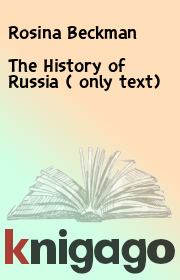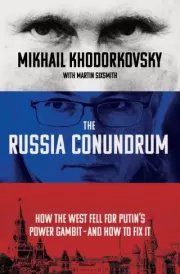Encyclopaedia Britannica - Russia
Название: | Russia | |
Автор: | Encyclopaedia Britannica | |
Жанр: | Старинная литература | |
Изадано в серии: | неизвестно | |
Издательство: | неизвестно | |
Год издания: | - | |
ISBN: | неизвестно | |
Отзывы: | Комментировать | |
Рейтинг: | ||
Поделись книгой с друзьями! Помощь сайту: донат на оплату сервера | ||
Краткое содержание книги "Russia"
Аннотация к этой книге отсутствует.
Читаем онлайн "Russia". [Страница - 2]
- 1
- 2
- 3
- 4
- . . .
- последняя (72) »
For the geography and history of the other former Soviet republics, see Moldova, Estonia, Latvia, Lithuania, Belarus, Kazakhstan, Kyrgyzstan, Tajikistan, Turkmenistan, Uzbekistan, Armenia, Azerbaijan, Georgia, and Ukraine. See also Union of Soviet Socialist Republics. Land
RussiaEncyclopædia Britannica, Inc.
Western Russia.Encyclopædia Britannica, Inc.
Typical wooden buildings in a village in the Central Ural Mountains near Kungur, Russia.© Wolfgang KaehlerRussia is bounded to the north and east by the Arctic and Pacific oceans, and it has small frontages in the northwest on the Baltic Sea at St. Petersburg and at the detached Russian oblast (region) of Kaliningrad (a part of what was once East Prussia annexed in 1945), which also abuts Poland and Lithuania. To the south Russia borders North Korea, China, Mongolia, and Kazakhstan, Azerbaijan, and Georgia. To the southwest and west it borders Ukraine, Belarus, Latvia, and Estonia, as well as Finland and Norway.
Extending nearly halfway around the Northern Hemisphere and covering much of eastern and northeastern Europe and all of northern Asia, Russia has a maximum east-west extent of some 5,600 miles (9,000 km) and a north-south width of 1,500 to 2,500 miles (2,500 to 4,000 km). There is an enormous variety of landforms and landscapes, which occur mainly in a series of broad latitudinal belts. Arctic deserts lie in the extreme north, giving way southward to the tundra and then to the forest zones, which cover about half of the country and give it much of its character. South of the forest zone lie the wooded steppe and the steppe, beyond which are small sections of semidesert along the northern shore of the Caspian Sea. Much of Russia lies at latitudes where the winter cold is intense and where evaporation can barely keep pace with the accumulation of moisture, engendering abundant rivers, lakes, and swamps. Permafrost covers some 4 million square miles (10 million square km)—an area seven times larger than the drainage basin of the Volga River, Europe’s longest river—making settlement and road building difficult in vast areas. In the European areas of Russia, the permafrost occurs in the tundra and the forest-tundra zone. In western Siberia permafrost occurs along the Yenisey River, and it covers almost all areas east of the river, except for south Kamchatka province, Sakhalin Island, and Primorsky Kray (the Maritime Region). Relief
On the basis of geologic structure and relief, Russia can be divided into two main parts—western and eastern—roughly along the line of the Yenisey River. In the western section, which occupies some two-fifths of Russia’s total area, lowland plains predominate over vast areas broken only by low hills and plateaus. In the eastern section the bulk of the terrain is mountainous, although there are some extensive lowlands. Given these topological factors, Russia may be subdivided into six main relief regions: the Kola-Karelian region, the Russian Plain, the Ural Mountains, the West Siberian Plain, the Central Siberian Plateau, and the mountains of the south and east. The Kola-Karelian region
Kola-Karelia, the smallest of Russia’s relief regions, lies in the northwestern part of European Russia between the Finnish border and the White Sea. Karelia is a low, ice-scraped plateau with a maximum elevation of 1,896 feet (578 metres), but for the most part it is below 650 feet (200 metres); low ridges and knolls alternate with lake- and marsh-filled hollows. The Kola Peninsula is similar, but the small Khibiny mountain range rises to nearly 4,000 feet (1,200 metres). Mineral-rich ancient rocks lie at or near the surface in many places.
Botanical garden on the Kola Peninsula, RussiaNovosti Press Agency
The Russian Plain
Western Russia makes up the largest part of one of the great lowland areas of the world, the Russian Plain (also called the East European Plain), which extends into Russia from the western border eastward for 1,000 miles (1,600 km) to the Ural Mountains and from the Arctic Ocean more than 1,500 miles (2,400 km) to the Caucasus Mountains and the Caspian Sea. About half of this vast area lies at elevations of less than 650 feet (200 metres) above sea level, and the highest point (in the Valdai Hills, northwest of Moscow) reaches only 1,125 feet (343 metres). Nevertheless, the detailed topography is quite varied. North of the latitude on which Moscow lies, features characteristic of lowland glacial deposition predominate, and morainic ridges, of which the most pronounced are the Valdai Hills and the Smolensk Upland, which rises to 1,050 feet (320 metres), stand out above low, poorly drained hollows interspersed with lakes and marshes. South of Moscow there is a west-east alternation of rolling plateaus and extensive plains. In the west the Central Russian Upland, with a maximum elevation of 950 feet (290 metres), separates the lowlands of the upper Dnieper River valley from those of the Oka and Don rivers, beyond which the Volga Hills rise gently to 1,230 feet (375 metres) before descending abruptly to the Volga River. Small river valleys are sharply incised into these uplands, whereas the major rivers cross the lowlands in broad, shallow floodplains. East of the Volga is the large Caspian Depression, parts of which lie more than 90 feet (25 metres) below sea level. The Russian Plain also extends southward through the Azov-Caspian isthmus (in the North Caucasus region) to the foot of the Caucasus Mountains, the crest line of which forms the boundary between Russia and the Transcaucasian states of Georgia and Azerbaijan; just inside this border is Mount Elbrus, which at 18,510 feet (5,642 metres) is the highest point in Russia. The large Kuban and Kuma plains of the North Caucasus are separated by the Stavropol Upland at elevations of 1,000 to 2,000 feet (300 to 600 metres).
Caucasus Mountains in Russia.© WaD/Shutterstock.com
The Ural Mountains
A belt of low mountains and plateaus 1,150 to 1,500 feet (350 to 460 metres) high flanks the Ural Mountains proper along the eastern edge of the Russian Plain. The north-south spine of the Urals extends about 1,300 miles (2,100 km) from the Arctic coast to the border with Kazakhstan and is extended an additional 600 miles (1,000 km) into the Arctic Ocean by Novaya Zemlya, an archipelago that consists of two large islands and several smaller ones. Although the Urals form the traditional boundary between Europe and Asia, they do not significantly
--">- 1
- 2
- 3
- 4
- . . .
- последняя (72) »
Книги схожие с «Russia» по жанру, серии, автору или названию:
 |
| Orlando Figes - The Story of Russia Жанр: Старинная литература Год издания: 2022 |
 |
| Rosina Beckman - The History of Russia ( only text) Жанр: Старинная литература Год издания: 101 |
 |
| Mikhail Khodorkovsky-ua - The Russia Conundrum - Mikhail Khodorkovsky-ua Жанр: Старинная литература Год издания: 2022 |


